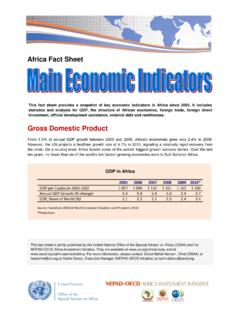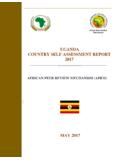Transcription of Measuring Performance in Public Debt Management : Key ...
1 1 Measuring Performance in Public debt Management : Key Findings from the debt Management Performance Assessment (DeMPA)1by Abha Prasad and Malvina Pollock This note focuses on the status of Public debt Management (DM) Performance in developing countries, primarily those classified by the World Bank as low- or lower-middle-income It describes how the debt Management Performance Assessment (DeMPA) tool measures DM Performance in individual countries, and draws on the findings from the 44 DeMPA reports that have been finalized to date to describe the current state of DM Performance and highlight particular strengths and weaknesses. Equally important, it illustrates how the DeMPA tool may be used by policymakers to manage some of the operational, institutional and technical challenges they face in meeting the requirements of modern day debt Management to ensure Public debt is managed effectively.
2 The arguments in favor of sound debt Management are compelling. Empirical evidence supports the view that higher the quality of a country s policies and institutions, the better is its capacity to carry debt and withstand exogenous Throughout history poorly structured debt in terms of maturity, currency or interest rate composition, and large unfunded contingent liabilities, have been an important factor in inducing or aggravating economic crises in many countries. Such crises, including the ones currently being experienced by some developed countries, underscore the need to be vigilant about borrowing levels and costs, and the DM framework within which these decisions are made and results monitored. Background The debt Management Performance Assessment ( DeMPA) is a tool developed by the World Bank, with inputs from regional and international technical assistance providers in debt Management , including the IMF in response to a growing concern within the international community about the adverse impact of passive or inadequate debt Management practices in developing countries (ref May 2007 Board paper).
3 This was further underscored by the World 1 This Note has been peer reviewed by Phillip Anderson, Tomas Magnusson, and Leonardo Hernandez. Comments and suggestions from Ian Storkey and Mike Williams are acknowledged. Inputs received from Signe Zeikate and William O Boyle on earlier drafts are gratefully acknowledged. Thanks to Ying Li for compiling the data. 2 The World Bank classifies countries by income groupings on their GNI per capita according to the Atlas methodology. For FY11 the classification is as follows: low income countries: $995 or less, lower middle income countries: $996-$3,945, upper middle income countries: $3,946-$12,195, and high income countries: $12,196 and above. 3 Kraay, A and Nehru, V, 2006, When is External debt Sustainable? World Bank Economic Review, Vol.
4 20, No. 3, pp 341-365. See also, WB-IMF (May 2007), Strengthening debt Management Practices - Lessons from Country Experiences and Issues Going Forward - Background Paper (Chapter III prepared by A. Prasad and F. Rowe). 2 Bank s Independent Evaluation Group report pointing that although countries had been given debt relief under the Heavily Indebted Poor Countries (HIPC) initiative and multilateral debt relief initiative (MDRI), most of them still had weak debt Management practices and functions4,5 . Further, the lowered debt burdens on account of the HIPC and MDRI debt relief had made several post-HIPCs attractive to non-traditional creditors that offered funds with terms and conditions with differing concessionality which could well lead to the re-accumulation of unsustainable debt burdens, if not managed prudently and effectively.
5 While debt relief provided new borrowing space and the opportunity to diversify instruments and sources of financing to meet large scale investment needs, more options can add to the complexity, and cost, of the debt portfolio and increase operational risks. In addition debt Management in these countries is often constrained by weak governance, lack of transparency, and shortage of skilled staff. In most low income countries, the government debt portfolio typically comprises the largest financial portfolio; on average, Public debt accounts for over 60 percent of If not properly managed, the structure of the debt portfolio may evolve in ways that could generate substantial ris ks to government balance sheets and affect the countries financial stability (Wheeler, 20047). Further, the economies of lower-income countries are less diversified than those at higher income levels: export bases are narrower, exposure to recurrent commodity price shocks is higher, and reliance on limited and unpredictable aid flows for budget support is often heavier8.
6 All these factors make lower-income countries highly vulnerable to exogenous shocks that can significantly, and rapidly, worsen debt dynamics. Such shocks can consist of sharp slowdowns in external demand and a contraction in export growth. As was the case in the current crisis, developments in advanced economies could precipitate fall in aid flows on which many lower-income countries depend. Combined with a drying up of already limited external private sources of financing, lower-income countries can be left with large financing gaps, especially if the outlook for continued official flows remains The challenges faced by these countries highlights the need to identify and address weaknesses in debt Management capacity. Moreover, some lower-income countries have already raised funds in international capital markets, and others are contemplating this step as market conditions improve.
7 However, several developing countries place a low priority on strengthening their DM systems and formulating coherent debt Management strategies. Until the development of the DeMPA, 4 World Bank, 2006, Independent Evaluation Group Report on the HIPC initiative . 5 As of June 2011,thirty-two countries have qualified for irrevocable debt relief under the HIPC and MDRI. Four countries have qualified for interim debt relief under HIPC. 6 See Preserving debt Sustainability in Low-Income Countries in the Wake of the Global Crisis (IMF and World Bank 2010) 7 Wheeler, Graeme (2004), Sound Practice in Government debt Management , World Bank. 8 Some countries depend on donor flows for up to 30-40 percent of budget support ( , Malawi, Rwanda) 9 See Dang, Knack, and Rogers (2010) for data on the effect of banking crises on aid flows from donor countries.
8 3 neither borrowers nor lenders had any tool to measure debt Management capacity in a systematic, comprehensive and objective manner. How debt Management Performance is measured Proper DM requires the formulation and implementation of a strategy that enables a government to prudently meet its financing needs, its cost and risk objectives, and any other goals that the government may have set for itself, , developing the domestic debt market. DM is a multi-faceted process that encompasses the governance and managerial framework, institutional and staff capacity, coordination with macroeconomic policies (fiscal and monetary), the policies and procedures for borrowing from external, domestic sources and the issuance of loan guarantees, cash Management , the Management of operational risk and the availability of systems for debt data storage, compilation, analysis and The overarching aim of the DeMPA framework is to guide countries in strengthening debt Management policies and institutions so as to better manage their debt in an effective and sustainable manner over the medium to long term.
9 It accomplishes this by assessing a country s debt Management policies and institutions against a benchmark of internationally accepted sound practices that are presented in the tool. As a result of these assessments, the DeMPA provides a foundation on which to build an actionable reform program and serves as a tool to facilitate monitoring of Performance over time. The focus of DeMPA is on central government DM and related functions, including the issuance of loan guarantees, on-lending, cash flow forecasting and cash balance Management . The DeMPA tool presents a set of 15 debt Performance indicators (DPIs) that are increasingly recognized as the international standards to evaluate strengths and weaknesses in DM Performance in a country. The tool helps to benchmark countries and evaluate the extent to which a government s DM practices conform to the internationally recognized standards given in the DPIs (see Annex A).
10 11 The DeMPA tool presents a scoring methodology, adapted from the Public Expenditure and Financial Accountability (PEFA) tool, and is based on a A to D scale. To meet the minimum requirements of each dimension a score of C is required. Scores of A or B indicate sound practice or strength , respectively. On the contrary, a score of D indicates the minimum requirements of the dimension are not met, signaling the need for corrective action. The assessment is based on information provided by the national authorities and presented in a DeMPA report which is submitted to the country authorities12 10 See DeMPA Tool and Guidance Note (World Bank 2009) for a full description.. Each report is reviewed by an independent group of debt Management experts to ensure cross-country comparability and objectivity.














